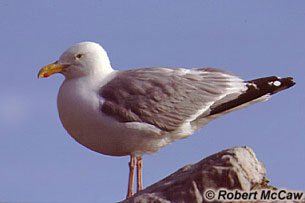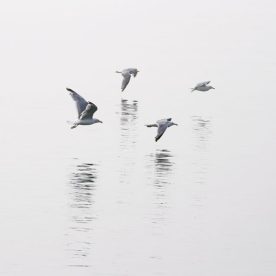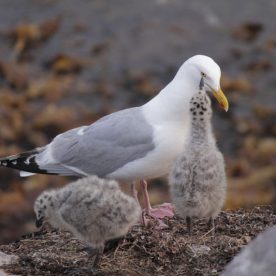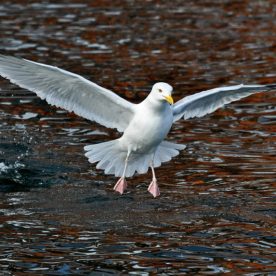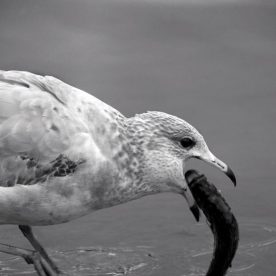Description
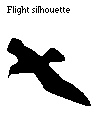 In Canada, most seagulls are Herring Gulls Larus argentatus. The adult Herring Gull is about 61 cm long from the tip of its bill to the tip of its tail. Its head, body, and tail are white, its bill is yellow with a red spot on the lower tip, and its legs are pink or flesh-coloured. The backs and upper wing surfaces of adult gulls are grey, and the tips of their outermost flight feathers are black with a white spot. In winter, the heads of adult gulls are streaked with brown. Immature birds are a mottled brown and take four years to develop full adult plumage.
In Canada, most seagulls are Herring Gulls Larus argentatus. The adult Herring Gull is about 61 cm long from the tip of its bill to the tip of its tail. Its head, body, and tail are white, its bill is yellow with a red spot on the lower tip, and its legs are pink or flesh-coloured. The backs and upper wing surfaces of adult gulls are grey, and the tips of their outermost flight feathers are black with a white spot. In winter, the heads of adult gulls are streaked with brown. Immature birds are a mottled brown and take four years to develop full adult plumage.
Signs and sounds
Herring Gull communication has been studied for several decades. A gull states its intent to stand fast by giving the trumpeting “long call.” It threatens to peck a neighbour by drawing itself up to look bigger, lowering its bill tip ready to strike, and pulling its “wrists” out of its body feathers. Then it steps stiffly towards its opponent.
Habitat and Habits
In winter, Herring Gulls are most likely to congregate on beaches along the shores of oceans and other large water bodies. In other seasons, gulls may range inland and can be found beside lakes and rivers, in grassy meadows, or on garbage dumps, golf courses, islands, cliffs, and buildings. Their main habitat requirement is a dependable source of food nearby.
Herring Gulls can be quite useful, keeping our beaches clean by eating dead fish and other garbage and leading fishing boats to schools of herring, one of their favourite foods—hence the name “herring” gull. On the other hand, the gulls will steal any fish catch left unattended for any length of time, and their excrement, or bodily waste, often damages the roofs of buildings where the gulls roost, or settle for rest.
Herring Gulls will nest in a variety of sites, but always near a body of water. On offshore islands, they frequently occupy flat ground. On the mainland, however, they tend to nest on cliffs, probably to avoid predatory mammals. In some places where food from human activities is abundant, they have begun to nest on roofs and window ledges of buildings. On cliffs, Herring Gulls tend to nest on turf-covered ledges.
Herring Gulls are very social birds and prefer to nest in colonies. Once a colony is well established, they are faithful to it and reluctant to settle elsewhere. In the lower Great Lakes area, for example, older, experienced breeding birds usually stay close to their colonies and are the first to reoccupy nesting territories in early spring. Some may use the same nesting site for as long as 10 to 20 years.
As the colony grows, some birds are unable to establish breeding territories. Sooner or later, these birds start to hang out near abundant food supplies. As the urge to breed grows, some start nesting at the new site, and the rush is on. In a very few years, the new colony may grow to capacity.
Although at first glance a Herring Gull colony may seem noisy and disorderly, there is some organization to it. Each pair occupies an area from which they drive other gulls and on which they nest.
When the Herring Gull population is dense, gulls will occupy all suitable places in their feeding area (as distinct from the colony). Adults on feeding areas drive away intruding gulls. If the fledglings (young Herring Gull chicks that have just started to fly, usually at about six weeks of age), already at a disadvantage because of their inexperience, were excluded from these feeding areas, their survival would obviously be endangered. However, chicks can lessen the adults’ territorial aggressiveness on the feeding areas by assuming a hunched posture, pumping their heads, and voicing shrill calls. The same behaviour causes parents to feed their chicks on the breeding colonies. Such adaptations reduce the rate of death of chicks at the times when they are most vulnerable.
Unique characteristics
The Nobel Prize-winning zoologist Niko Tinbergen and his students have studied how the Herring Gull’s behaviour is related to the survival of individual birds. They have observed that the parent gulls take extremely good care of their eggs during incubation, turning them gently with their bills from time to time to ensure even development of the embryos. After hatching, the gulls immediately remove the broken eggshells, as their white inner surface might attract predators. Encountering the jagged edge with the bill apparently stimulates the adult to grasp the shell and fly off with it. This task occupies only a minute of the adult’s time once a year, and every bird performs it.
Tinbergen also observed that the sight of the parent’s bill stimulated the newly hatched chick to peck at it. In response, the adult (whether experienced or not) regurgitated food. By using models of the adult’s head, Tinbergen showed that chicks pecked more vigorously at a bill with the normal red spot near the tip than at one without it. They also responded more vigorously to a long, thin bill than to a short one. In fact, a pencil with a red eraser on the end of it elicited the most vigorous pecking.
Range
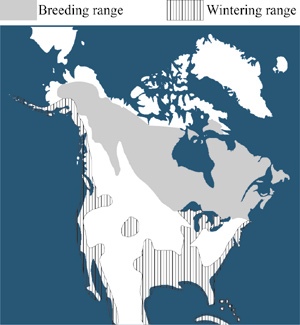
Herring Gulls are one of the most widespread species in Canada. Indeed, their breeding range includes every province and territory in Canada. Their main nonbreeding range includes the Pacific and Atlantic coasts, the southern United States, the coast of the Gulf of Mexico, and a few Caribbean islands. In the lower Great Lakes area, the species can be found year-round.
Of the 43 species of gull found in the world, 16 have bred in Canada, but three have nested only occasionally. Specialized feeding techniques and different ranges prevent, or at least reduce, competition between species.
Although the Herring Gull is the most numerous of all gulls through most of its Canadian range, the closely related Glaucous-winged Gull Larus glaucescens is more common on the west coast. The Great Black-backed Gull Larus marinus, found mainly on the Atlantic coast, is a powerful flier offshore. The smaller Ring-billed Gull Larus delawarensis feeds more on food taken on land than does the Herring Gull and is much more abundant on the Great Lakes. Bonaparte’s Gull Larus philadelphia is a faster, more erratic flier, picking small prey from the water or sitting and pecking like a chicken; it nests in trees in the forests northwest of the breeding range of the larger gulls. The cliff-nesting Iceland Gull Larus glaucoides occurs in the northern part of the Herring Gull range, coming south in winter to the coasts of the Atlantic provinces. In the far north are cliff-nesting Glaucous Gulls Larus hyperboreus, and even farther north, on the Arctic islands and northern Greenland, are species such as Sabine’s Gull Xema sabini, Ivory Gull Pagophila eburnea, and Ross’ Gull Rhodostethia rosea, which southern Canadians seldom see.
Feeding
Herring Gulls regurgitate, or bring up, food remains that they cannot digest. Analyses of these “pellets” and of their feces show that Herring Gulls, like most other gull species, will eat almost anything—clams, small fish, floating dead animals, small young and adults of other nesting birds, bread, french fries, and so on.
They have a knack for finding places where food is abundant, such as fish wharves and garbage dumps. Diet studies in the Great Lakes area showed that most pellets in colonies near large urban centres contained remains of garbage as well as various fish species. Pellets in colonies near agricultural areas often had the remains of small mammals, notably deer mice.
Individual Herring Gulls tend to specialize in particular types of food or feeding techniques. Within a large colony, some birds may regularly visit dumps, while others may feed entirely on fish and crabs found on the seashore. A few individuals take to cannibalism, watching their neighbours for an opportunity to sneak in and remove an egg or chick. These birds are often breeding birds that have lost their own brood. Although large numbers of Herring Gulls in North America are almost entirely dependent on human activities for their food, there are still populations breeding on offshore islands or in remote parts of the low Arctic that exist on a natural diet.
How far will Herring Gulls from a colony travel to get all the food they need to sustain themselves and raise their young? In one study, breeding gulls were caught and coloured several bright tints so that their daily trips for food could be traced. The vast majority of the gulls sought their food as close as possible to their breeding colony. If there was a fish pier within 8 km, few gulls went farther. If the nearest dump was 27 km away, commuting that far was regular. Even 40 km was not an unreasonable daily round, if there was nothing nearer and the rewards were attractive enough.
Breeding
Courtship begins as soon as birds arrive at the colony in the spring, usually mid-March. Once pairing has taken place, the birds build a nest or, more often, refurbish an old one. The nest is circular and lined with moss or grass, which is also used to build up the rim. In most areas, a group or clutch of three eggs will be laid by mid-May. Eggs are normally incubated, or kept warm until they hatch, for 26 to 28 days.
Females laying for the first time, usually in their third or fourth year, often lay only one or two eggs. They also tend to lay later in the season than more experienced birds, which generally make up about three-quarters of the breeding population.
Eggs are well looked after, but they can be lost. Some are eaten or stolen by other gulls, and others are washed away by storms. Birds that lose their eggs early in the season will usually lay additional eggs to replace the ones that were lost.
The greatest losses in the colony are usually of tiny chicks in the first few days after hatching, probably as a result of predation by neighbouring gulls. When they start to run about, chicks do not know the borders of their parents’ territory, and the adults have to guard them against neighbours who would kill trespassers. Spots on the top and back of the chick’s head identify each chick individually; the adults learn these markings in the first few days. These spots are the last of the downy plumage to be lost.
Mortality among older Herring Gull chicks is mainly caused by food shortages. In one study, each pair produced an average of one chick a year, which were ready to leave the colony at 40 to 60 days of age. However, about one-third of those chicks died before another month had passed because they could not fend for themselves.
Conservation
At the end of the 19th century, gulls were rare along the Atlantic coast. In those years, many farming and fishing families led difficult lives on outer islands, tending gardens, fields, and flocks and fishing with nets and lines. Any bounty from the sea was welcome, and gull eggs and young were worth considerable exertion. Additional pressure on gull populations resulted from the millinery trade’s demand for bird feathers, which were fashionable decorations on hats.
The 1900 census of the Atlantic coast showed fewer than 4 000 Herring Gull pairs—all in New Brunswick and eastern Maine. In 1965, however, censuses showed about 100 000 pairs on 240 colonies along the shore from New York City to Grand Manan, New Brunswick. Since then, the Herring Gull breeding population has increased further and has expanded to include all the Maritime provinces in Atlantic Canada and the Atlantic coast of the United States from Maine to Virginia.
There are several reasons for the dramatic increase in numbers over the 20th century. As the standard of living rose and the use of inboard engines spread, families gathered into coastal villages at safe harbours, leaving the outer islands to the thunder of the surf and the cries of the seagulls. Another reason was the Migratory Birds Convention, which was signed by Canada and the United States in 1916 and which encouraged cooperation between the two countries in the protection and management of migratory birds. Most important, perhaps, was the gulls’ readiness to exploit new food sources provided by human waste. In many places, these scavengers doubled their numbers every 15 years—so large an increase that they are now a nuisance in some metropolitan areas and a potential hazard to aircraft flying in and out of airports.
In Quebec, a census of Herring Gulls and other seabirds that nest in the bird sanctuaries on the North Shore of the Gulf of St. Lawrence has been carried out nearly every five years since 1925. The Herring Gull population increased from 650 to 8 000 nesting pairs between 1925 and 1975, increased further to 14 000 pairs by 1988, but then decreased dramatically in most sanctuaries to about 3 000 pairs in 1993. This general decline appears to be related to a decrease in the amount of fish offal, or waste, that was available to the gulls, which was the result of a decline (and total collapse in 1993) of the commercial cod fishery in the area. However, the drop in Herring Gull nesting pairs was not uniform across the bird sanctuaries.
In the freshwater environment of the Great Lakes, some 77 000 Herring Gull nests were counted (42 000 nests in the Canadian portions of the lakes and 35 000 on the United States side) during surveys between 1989 and 1991. When a species has a very large breeding range, like the Herring Gull does, it is likely that there will be increases and decreases in nest numbers occurring more or less simultaneously in different parts of the range. This has indeed occurred over the last few decades in the Canadian portions of the Great Lakes, and those changes are thought to be caused by local changes in food availability.
Although humans no longer kill Herring Gulls to satisfy a heavy commercial demand for their feathers, their activities still have negative effects on the birds. In the mid-1960s and early 1970s, Herring Gulls nesting on the Great Lakes were found to be experiencing reproductive failure—although there were lots of nests, there were hardly any chicks to be found. Detailed studies showed that early deaths of embryos and abnormal parental behaviour during incubation were at least partly responsible for the reproductive failure, and scientists suggested that high levels of organochlorine compounds (including polychlorinated biphenyls, or PCBs, DDT-related compounds, and mirex) in both adults and eggs were to blame.
In the early 1970s, a long-term monitoring program on the Great Lakes was set up by the Canadian Wildlife Service in conjunction with the International Joint Commission to better understand the effects of prolonged exposure of bird populations to persistent toxic chemicals. Herring Gull eggs were used because the fat-soluble contaminants are transferred from the female parent to the egg yolk. The monitoring program showed that the levels of most contaminants had declined by up to 90 percent or more by 1995. However, lower levels of dioxins, PCBs and other related chemicals are still present in the Great Lakes due to undetected sources, atmospheric deposition, and release from contaminated bottom sediments.
Herring Gulls are very adaptable, in that they eat almost anything and will nest almost anywhere, both in natural areas and in the human landscape. Now that human persecution is largely a thing of the past and with contaminants at much lower levels, we may confidently expect that the Herring Gull will continue to thrive.
Resources
Online resources
Audubon Field Guide, Herring Gull
Print resources
Campbell, R.W., N.K. Dawe, I. McTaggart-Cowan, J.M. Cooper, G.W. Kaiser, and M.C.E. McNall. 1990. The birds of British Columbia. Volume II. Royal British Columbia Museum, Victoria.
Gauthier, J., and Y. Aubry, editors. 1996. The breeding birds of Québec: Atlas of the Breeding Birds of Southern Québec. Association québécoise des groupes d’ornithologues, Province of Quebec Society for the Protection of Birds, and Canadian Wildlife Service, Québec Region, Environment Canada, Montréal.
Godfrey, W.E. 1986. The birds of Canada. Revised edition. National Museums of Canada, Ottawa.
Pierotti, R.J., and T.P. Good. 1994. Herring Gull. In A. Poole, P. Stettenheim, and F. Gill, editors. The Birds of North America, no. 124. Academy of Natural Sciences, Philadelphia, Pennsylvania; and American Ornithologists’ Union, Washington, D.C.
Ryckman, D.P., D.V. Weseloh, and C.A. Bishop. 1997. Contaminants in Herring Gull eggs from the Great Lakes: 25 years of monitoring levels and effects. Great Lakes Fact Sheet. Canadian Wildlife Service, Ontario Region, Burlington.
© Her Majesty the Queen in Right of Canada, represented by the Minister of the Environment, 1973, 1979, 1980, 2002. All rights reserved.
Catalogue number CW69-4/10-2002E
ISBN 0-662-31148-5
Text: William H. Drury
Revision: Hans Blokpoel, 2001
Photo: Robert McCaw



